Sometimes, you need to bring in somebody else to tell you that your baby is ugly.
That’s exactly what Caltech did; in this case, the baby in question was their facilities department, which was lacking functionality and coordination. Caltech's commitment to change resulted in a multi-year effort, transforming them into an integrated organization with process, people, and technology tied together for maximum efficiency.
At the Higher Ed Facilities Forum, Jim Cowell, AVP for Facilities, and Matt Berbee, Director of Maintenance & Energy Services, discussed this transformation to give other universities valuable takeaways on enhancing collaboration and embracing data-driven decision-making within their own organizations.
A Need for Change
Before Caltech’s external assessment that confirmed, yes, their baby was ugly, they conducted an intensive internal assessment. Caltech was seeking to upgrade their maintenance management system by identifying requirements through assessment, rather than simply installing new technology.
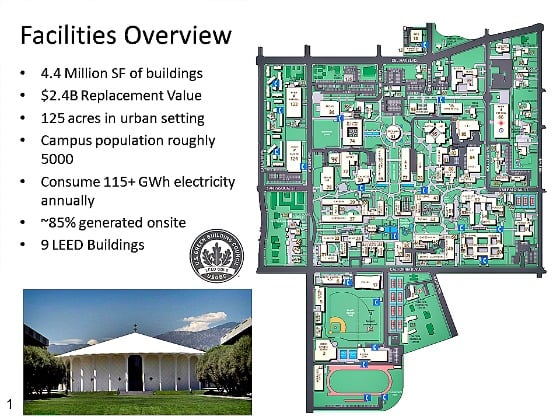
An overview of Caltech's space management.
This assessment included many moving parts, including but not limited to: assessing business practices, creating and measuring organizational readiness, identifying and reducing waste, and managing the lifecycle of asset information from construction, commissioning to operations including predictive maintenance best practices.
The facilities transformation boiled down to three steps...
1) Identify performance assessment and implementation strategies to improve organizational capacity.
2) Identify key factors to lead/manage a successful implementation
3) Identify the performance metrics to support the change and measure success
What Caltech discovered was that there was no comprehensive preventative maintenance program, and customers were frustrated by a lack of access to information on the status of orders. In order to be better stewards to their assets, it was essential to create a maintenance management system that optimized wrench time for the mechanics, plus a slate of performance metrics, and also to implement a mobility solution to handle the maintenance.
An Integrated Process
In the creation of new business processes, Caltech employees were engaged every step of the way. Cowell stressed that it’s essential to be honest and communicative because resistance is an inevitable side-effect of any organizational change.
“Since all shops had a different process, we had to agree on one. We had a very structured outreach program,” Cowell said.
Berbee went on to share examples of what’s been implemented in different key areas, starting with assets.
“There’s a lot of value to pursuing integration, and we selected a new integrated workplace management system because of how critical assets are. You cannot manage what you do not know, and if the asset inventory isn’t accurate, it’s costing your organization time, money, manpower, and energy,” Berbee said.
Caltech prioritized the creation of a clear definition of an “asset,” so that technicians are all on the same page on what to track. The organization held a workshop to educate employees, providing tests and tools to familiarize them. A more detailed description of Caltech’s method to building the asset inventory is below...
How to Build an Asset Inventory
1) Establish a data owner--Caltech created an “Asset Czar” role where this is the primary job.
2) Location/space verification; for Caltech, this meant updating property maps and coding it with property numbers.
3) Collect data requirements (“If that data quality isn’t there, it’ll be hard and expensive. We built templates so the data is presented in a way we can manage cleanly.”).
4) Develop a master list.
5) Evaluate current asset data.
6) Make a prioritized plan.
7) New construction/renovation specs for asset management.
8) Establish asset management process.
Caltech surveyed 20+ universities to find out how many asset records others have, and discovered that the number really depends on the type of inventory.
“We have just under 3,000 asset records per million square foot. I can’t say if that’s necessarily right or wrong, but it is a data point we can track,” Berbee said.
Work management
Though Caltech’s goal was to provide reliable and predictable service, coming from a place with no processes or robust asset management system made that goal difficult to obtain.
“We decided not to try and reinvent the wheel, and started with APPA classifications for work and introducing work order priorities,” Berbee said. “Before, everything was ‘priority number one,’ so, by default, nothing was truly an emergency.”
“Life of a work order” was a new concept for the organization. It meant taking the time to communicate the touch points and email the customers about the status, from a confirmation that the work order has been received to closing it.
The new goal was for 80% of work to be scheduled through AiM.
“If its scheduled through the system, it means the email goes to the customer, which is a huge positive change from assigning everything manually,” Berbee said.
Material Management
Material management was another area in need of an upgrade.
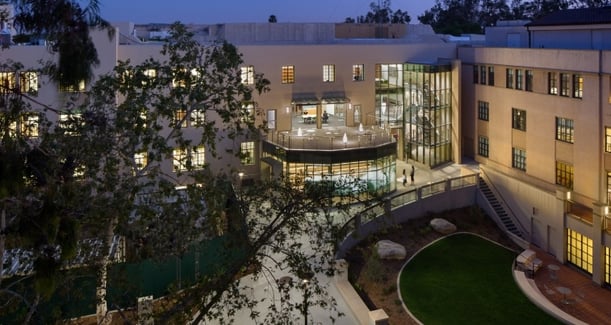 Caltech campus.
Caltech campus.
Caltech set out to measure “non-wrench time,” aka, the time it took employees to transport materials. The team put a GPS in all of the carts, and the results showed that multiple trips a day to the stockroom was wasting valuable time.
Following this revelation, goals for the material management redesign were set...
1) Have the materials we need, when we need it, within arm’s reach of technicians.
2) Maximize mechanics’ wrench time. Increase average wrench time by 45 minutes per day by stopping trips back and forth to the stockroom.
3) Minimize supervisor & eliminate mechanics time spent ordering and obtaining new materials.
4) Manage shop stock. Identify, reduce, control, make available for use easily and quickly--without counteracting the above goals.
5) Part requests will be taken at the time of work, or ahead of time via electronic means, phone, issue request, etc.
Caltech also got rid of the stockroom window, instead opting for materials to be delivered to pickup locations. Metrics have shown that the new process is taking off, with the number of FTE manning these operations reduced, the number of will calls (“special handling”) reduced, and material requests on the rise.
Energy Management
At Caltech, their energy program is financed through a green revolving loan fund that’s been recognized with a number of awards. Although they had a robust program, there was still room for improvement-- specifically in terms of harnessing the hundreds of data touch points in each lab on campus.
 Caltech's campus contains roughly 5,000 solar panels that provides about 2% of the campus's power annually.
Caltech's campus contains roughly 5,000 solar panels that provides about 2% of the campus's power annually.
What’s important, Berbee said, is being able to prove the payback that your energy program provides--”It doesn’t do me any good if the savings on paper don’t materialize. We take ‘Value Beyond Payback’ pretty seriously."
That value is for the whole organization. It might be on the financial side where you have a payback or rate-of-return, and it might mean you have an opportunity to go after a new process or technology to inform your processes.
At the core of it, the payback is about happy people. “We want our researchers happy knowing they are supported with the best labs in the world. We want them confident they can put a work order in for us and we’ll be right there to help them,” said Berbee.
Caltech set a number of goals in the energy department, including:
- Test everything through commissioning.
- Deliver automated functional performance tests for use in the Predictive Maintenance Program.
- Develop an asset inventory and start developing an asset history during commissioning.
- Develop tools to answer “how is building performing?”
- Reduce future O&M costs.
Now, with Caltech’s new system, “How is my building performing?” is Berbee’s favorite question.
They developed new processes and tools integrated into the AiM work management system to handle this complexity, using a distributed building analytics platform called SkySpark. The process is smart commissioning: think of it as an enhanced form of commissioning that uses analytics and BIM.
“Because we standardized the control sequences that run these facilities, I can now automate those tests that were pass-fail. You’ve got to have good data quality-- automated Cx requires all points to be named consistently or tagged with a searchable convention,” Berbee said. “With predictive maintenance and a system like this, you should be ahead of the curve-- so we say, if it’s too hot, it’s too late!”
Caltech is the first AssetWorks customer to bring the AiM reactor online, barely a year after their vision for connecting AiM to our BAS.
“In AiM speak, it has the reactor: in our system, the platform that grabs it from SkySpark, and shoves it into assets and work orders is called a reactor. All of that is intended to give our team more tools,” Berbee said.
All of these tools are integrated into the system so that when a team member gets that work order, the asset is already attached, and it gives a clear view of the problem that was simply impossible when done manually.
Also, in the transition to operations, Caltech coded from commissioning the things that their operators need to be watching for, whether it’s pressure problems or valve failures.
It’s not just Caltech who is interested in smart commissioning.
“A host of organizations are learning about this process because they know it’s the future. It doesn’t cost you any more to do all this, so there’s a lot of value,” Berbee said. “There’s more possibilities and tools that can finally tell you the optimal time to change filters and make work orders. Forget doing it quarterly or semi-quarterly: this data can not only tell you exactly when to do it, but why.”
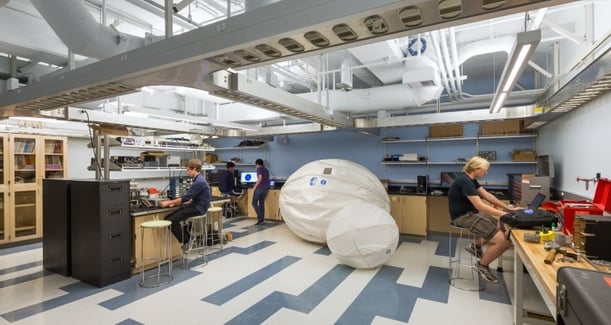 One of Caltech's many research labs.
One of Caltech's many research labs.
Project Management
The last piece of the puzzle Berbee discussed was project management.
“In PM, you have trade availability (are shops available for the work?), is there asset inventory information that I need to watch, and I want to give the shops a chance to bid on the work,” Berbee said. “In this example, if I’m setting up a project, that initial set-up triggers space management to say: is new space being created, updated, or changed? Asset management gets a notification through workflow to say, stop, maybe your affecting work I’m doing, so your either adding, removing, or modifying assets in my inventory.”
By thinking in an integration fashion, you no longer “have these things ripped out and plugged in sloppily without shops even knowing about it.”
Finally, inspections now happen through the system so there’s a clear report that all the shops had their eyes on the assets that were installed, their tagged in a way they can read and reach with their scanners.
“This is all possible thanks to integration, the processes behind it, and the people behind it who were trained to use these tools,” Berbee said.
The People Factor
How did Caltech pull off such comprehensive change within the organization?
According to Berbee, it boils down to realizing that implementation is not installation. “You have to address the business and human objectives you’re trying to achieve,” he said.
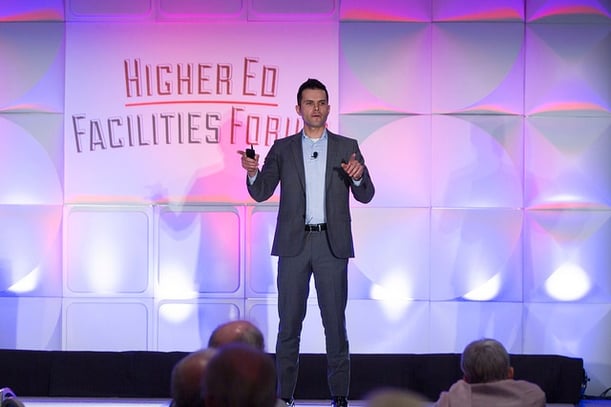 Matt Berbee at the Higher Ed Facilities Forum.
Matt Berbee at the Higher Ed Facilities Forum.
In any organization, there are going to be people who are happy with the changes and those who aren’t.
At Caltech, the team came up with names for the different attitudes in the workforce. Those employees leading the change were referred to as “the rough-water swimmers.” Right behind them were the water skiers who don’t mind being alone as their being pulled along, and the inner-tube riders are also following, who are going to be comfortable no matter what. It’s the anchors and the salmon, who are swimming the wrong way, that needed to be identified so that their concerns and issues can be addressed.
“Steering and supporting transition is a leader’s prerequisite for a successful implementation,” said Cowell. “We were very careful in the beginning to keep everyone moving forward, and we surveyed them to see how they felt about the change. As we addressed those concerns, we had only a few anchors/salmon at the end.”
Training was a big component of addressing employee hesitations. Caltech built a computer lab for the the training, which is now used for new people coming into the system and made sure that every technician was tested before going into the live environment. Employees were also encouraged to submit “tips of the week” that were published as the staff got the hang of the new system.
That training also extended to their customers, who were used to a process-free world; a customer portal was built so they could enter the work online and learn about work-order status instead of calling in.
Finally, in August 2016, the day came where Caltech went live.
“We turned one system off and the other system on, and realized the world didn’t end, but the work isn’t done. Now you have to figure out if your getting the value for the work you’ve done,” Cowell said.
The big question is (“Is AiM helping us achieve our goals?”) was addressed in a number of ways.
“With a data-rich system like this, there's an overwhelming array of metric options. We got our steering group together to figure out the right metrics,” Cowell said.
The team also had help from the balanced scorecard, a tool that aligns strategy with execution.
“It helps you develop marching orders for your organization so you can really figure out what your going measure and how your going do the work,” Cowell said.
They started with a facilities strategy map where key focus areas were aligned (operations, people, finance, customer), and goals were set within those key focus areas. KPI’s and initiatives were developed in each area, and progress was measured and displayed on the “Facilities Wall of Metrics.”
What Metrics Has Caltech Seen So Far?
In the last couple of months, more people are using the portal than calling, revealing that people are getting comfortable with the technology. The amount of time it takes to get the work is decreasing. Implementation of work order priority has changed Caltech’s culture from “everything is an emergency” to ⅔ routine work and only 1% treated as an emergency--a sign of a far healthier facilities organization.
“We met our goal of scheduling 80% of work, and we’re looking at standout metrics now like fume hood downtime. We have a thousand fume hoods, so it’d be nice to understand how the coordination between everything is going in terms of keeping them up and running,” Cowell said.
In the end, Caltech achieved a goal that was previously unthinkable, transforming from a process-free organization to an integrated organization that relentlessly pursued data to validate key milestones and accomplish more.
To watch the full talk from the Higher Ed Facilities Forum, check out the video below:

Posted by
Join us at HEFF!
An interactive retreat for facilities leaders at the nation's top colleges and universities.
Nov 8-10, 2026 | San Antonio, TX
Learn More

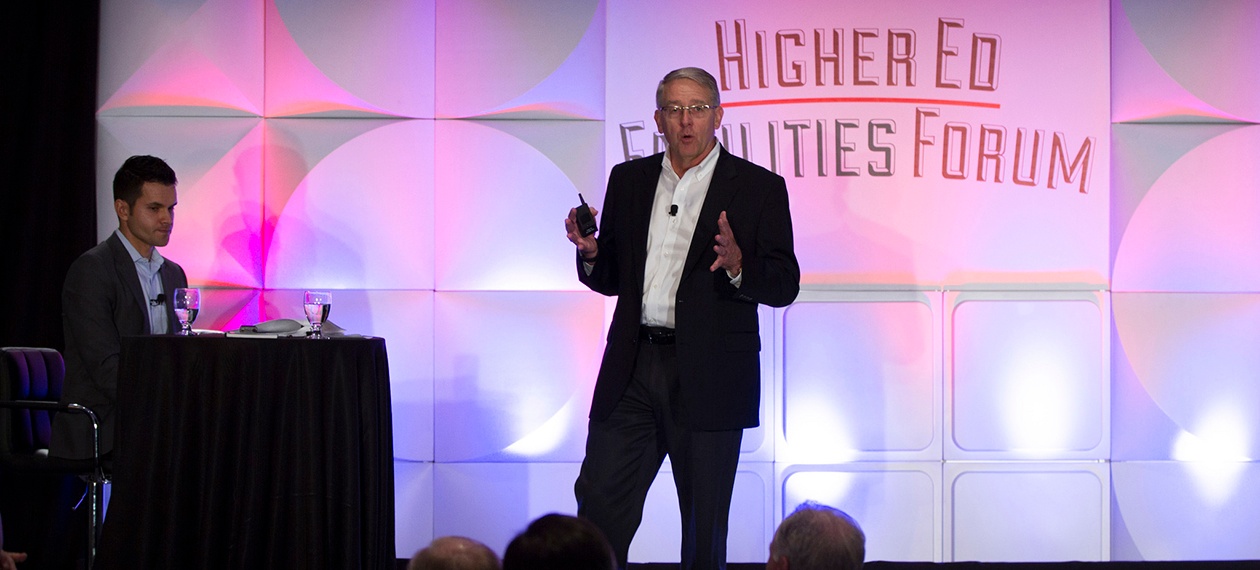







Comments